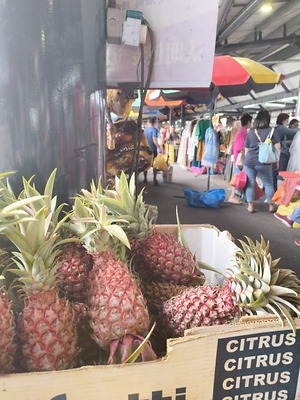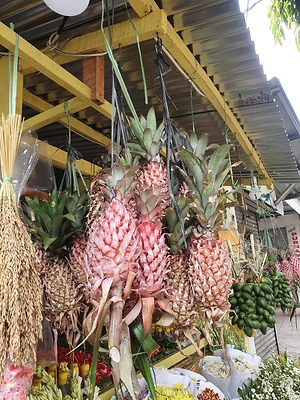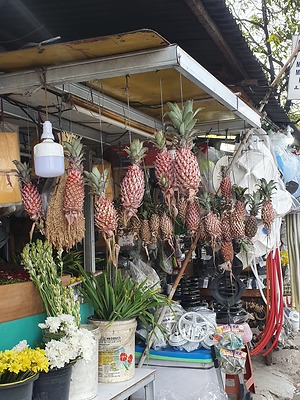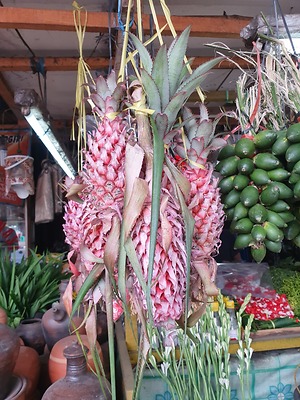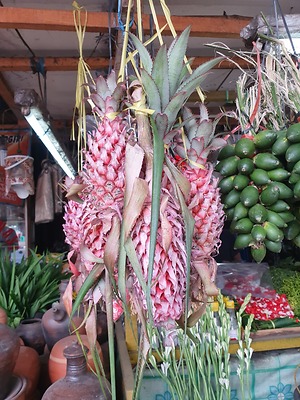

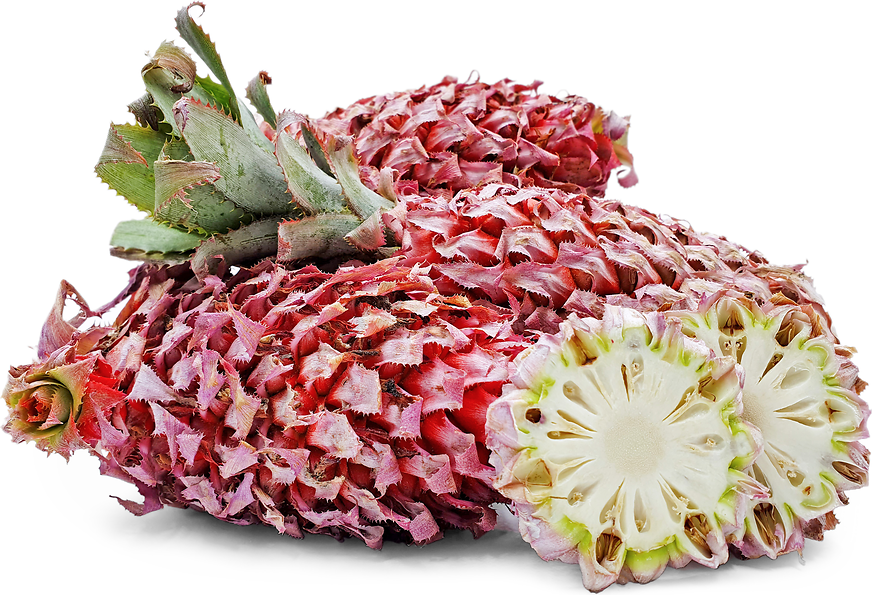
Red Pineapples
Estimated Inventory, lb : 0
Description/Taste
Red pineapples are generally smaller than common commercial pineapples and grow on a thick stem that is nestled among curved, elongated, and pointed leaves. The oblong to cylindrical fruit has a waxy, fibrous skin that is covered in downward-facing, red-pink spines, and the fruit connects to a leafy and spiked, variegated green-red crown. Underneath the tough skin, the flesh contains hues of white, yellow, and pink, and is dense and somewhat chewy, encasing a hard, central core. Depending on the climate the fruit is grown in, the flesh can be juicy with a sweet and slightly tangy taste and may or may not contain seeds.
Seasons/Availability
Red pineapples are available in the summer through fall in tropical climates.
Current Facts
Red pineapples, botanically classified as Ananas bracteatus, are brightly colored fruits that grow on evergreen plants and are members of the Bromeliaceae or bromeliad family. Native to tropical and subtropical regions of South America, Red pineapples have been introduced around the world as an ornamental plant, highly valued for their showy red fruits and multi-colored leaves. There are several varieties of Red pineapples, and the small fruits are rare to find in commercial markets. Red pineapples are typically found in home gardens and are often used as a natural defense along property lines to protect against unwelcomed animals and people. Though the plants are mainly considered to be ornamental, in tropical climates with a high amount of rainfall, Red pineapples are edible and are consumed fresh or juiced.
Nutritional Value
Red pineapples are an excellent source of vitamin C, which is an antioxidant that can help boost the immune system and contain bromelain, which is an enzyme that has anti-inflammatory properties. The pineapple also contains fiber and manganese, which has been shown to help protect bone composition.
Applications
Red pineapples are edible but will vary in texture and flavor depending on the climate and amount of water the plant has received during the growing process. The fruit can be consumed fresh, out-of-hand by removing the skin, crown, and bottom to expose the flesh. The flesh can then be cut away from the core and diced into pieces. Red pineapples can also be used in fruit salads alongside mangoes, bananas, and citrus, added to smoothies, and pureed or juiced for use in sauces, marinades, and cocktails. In addition to fresh applications, Red pineapple slices can be dried for extended use. Red pineapples pair well with roasted meats such as ham and chicken, creamy cheeses such as blue cheese or cream cheese, black garlic, fennel, and basil. The fruit will keep up to five days when stored whole and upside-down to allow sugars to redistribute from base to crown in the refrigerator. Sliced pieces of fruit will keep 1-3 days when stored in a sealed container in the refrigerator.
Ethnic/Cultural Info
In Indonesia, Red pineapples have become a modern symbol for prosperity and protection during the Chinese New Year and are favored for combining two ancient traditions into one decoration. Also known as Imlek or the Lunar New Year, the Chinese New Year is celebrated by millions of Chinese Indonesians, and pineapples are regarded as lucky because their Chinese name sounds similar to the Chinese words for “fortune or prosperity” in certain dialects. Pineapple decorations are adorned in houses and restaurants, and both the real fruit is used along with constructed pineapple lanterns made from paper. Pineapple tarts are also a favored treat during the celebration and are made with a sweet jam delicately placed on top of a baked pastry. In addition to pineapples, the color red is believed to ward off evil during festivities and is displayed through clothing, decorations, and food.
Geography/History
Red pineapples are native to South America and have been found growing in cloud forests, along coastlines, in highlands, and in tropical forests in Brazil, Uruguay, Paraguay, and Argentina since ancient times. The brightly colored fruit has also been introduced via trade to other tropical and subtropical regions around the world, including Southeast Asia, Australia, New Zealand, and Hawaii. Today Red pineapples are not commercially grown on a large scale and are predominately found as a specialty, ornamental variety in home gardens.



